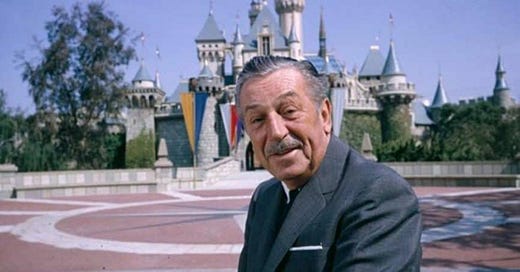Welcome to Issue 9 of Becoming Berkshire; we remain in 1966 as we have more to cover. In addition to the Buffett Partnership investing in Hochschild, Kohn & Co., Buffett acquired 5% of the Walt Disney Company, and Berkshire Hathaway paid its only dividend of 10 cents per share!
The Walt Disney Company
Buffett was so fascinated by Mary Poppins' theatrical success that it piqued his curiosity about the type of Moat Disney had and their ability to produce durable earnings.
Roger Lowenstein’s excellent biography Buffet: The Making of an American Capitalist details Buffett’s investment in the Walt Disney Company:
While Buffett was in New York, he went to see the Company's latest film, Mary Poppins. Needless to say, Buffett was not so interested in Julie Andrews, but in the stock. Settling into a seat with his tweeds, briefcase, and popcorn, he noticed the other patrons staring at him. He suddenly realized he was the only adult unaccompanied by a child and must have looked rather odd.
But when the theater went dark, the other moviegoers forgot him. Buffett saw that they were riveted to the picture, and he asked himself, in effect, what it would be worth to own a tiny bit of each of those people's ticket revenues - for today and tomorrow and as many tomorrows as they kept coming back to Disney.
In the summer, when the Buffetts were in California, they went with the Mungers to Disneyland. While the kids did the park, Buffett and Munger discussed it financially, ride for ride, a kind of Fellini fantasy version of a corporate balance sheet.
Subsequently, Buffett visited Walt Disney himself on the Disney lot. The animator, meeting him in shirtsleeves, was as enthusiastic as ever. Buffett was struck by his childlike enchantment with his work- so similar to Buffett's own.
Disney stock, meanwhile, was trading at only about ten times earnings. Buffett tried to analyze it not as a stock but as a whole company, perhaps as a business down the street in Omaha that was willing to sell him part ownership. In Buffett's view, its most valuable feature was its library of old cartoons and films, such as Snow White and Bambi. A Ben Graham would not have been interested in such an imprecise asset. However, Buffett estimated that, on a proportional basis, the library alone was worth the price of a share. Plus, we would own a slice of Disneyland, and he would have the unpretentious Mr. Disney as his partner. With such thoughts in mind, Buffett bought 5 percent of Disney for $4 million.
Buffett, it should be understood, was not abandoning the Graham credo of hunting for securities that were well below "intrinsic value." But his definition of value was changing, or rather, broadening. To Buffett, the value of Disney's film library, even though imprecise and mainly off the books, was no less real than a tangible asset such as a factory. 1
Keep reading with a 7-day free trial
Subscribe to Becoming Berkshire to keep reading this post and get 7 days of free access to the full post archives.




